Operation of the Homeless Persons Legislation in Scotland: 2012-13
This bulletin provides information on homelessness applications, assessments and outcomes to 31 March 2013. It includes information on the characteristics of applicant households, local authority assessments and the action taken in respect of cases that were concluded. Snapshot data on households in temporary accommodation at 31 March 2013 are presented and notifications of households at risk of homelessness due to eviction/repossession.
5. Outcomes
Contact maintained/ lost
5.1. In 2012-13, councils closed 40,751 cases. (Table 9a and Chart 19) Of these, contact was maintained until case closure for 30,279 applications (74% of cases). This was an increase of one percentage point over 2011-12. In 2012-13 contact was lost before assessment for 2,204 (5% of) cases and was lost after an assessment in 4,708 (12% of) cases. The overall proportion of lost contacts has remained the same between 2011-12 and 2012-13.
Chart 19: Applications closed from 2010-11 to 2012-13
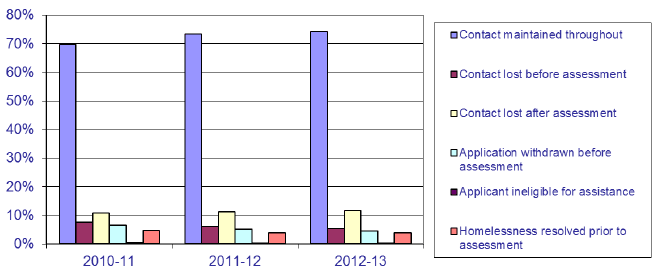
Accommodation offered and taken up
5.2. Chart 20 and Table 8c show the offers of accommodation and outcomes for the 28,281 cases assessed as homeless, where contact was maintained until the application reached its conclusion in 2012-13. Of these, 19,012 were offered a social rented tenancy, most of whom (17,052 cases or 90%) took up the offer. Temporary accommodation was offered to 2,222 households, of whom 1,697 (76%) took up the offer; and a private rented tenancy was offered to 1,323 households, almost all of whom 1,303 (98%) accepted the offer.
5.3. The last actions of local authorities towards cases assessed as priority homeless remains very similar to 2011-12 with 70% of cases being offered a social rented tenancy and 4% being offered a private rented sector let. (Table 8d)
Chart 20: Scotland 2012-13: Action taken by local authority where applicant was assessed as homeless
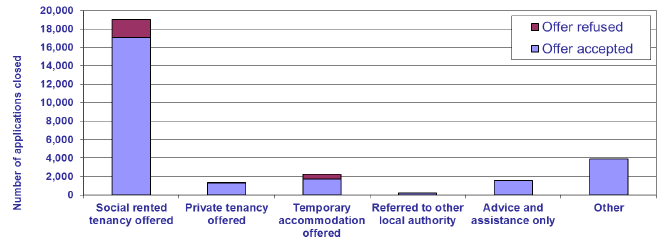
Overall outcomes
5.4. In 2012-13, settled accommodation was secured for 20,610 (68%) of the 30,279 applications where contact was maintained through to completion of the application. (Table 8b). Within this, 20,036 priority homeless applicants (75% of priority homeless) secured settled accommodation. Settled accommodation was also secured by 367 non-priority homeless (24% of non-priority homeless) and 207 who were assessed as not homeless (10% of those not homeless). The proportion of priority homeless applicants securing settled accommodation (75%) is one percentage point higher than in 2011-12.
Chart 21: Scotland: 2012-13: Housing outcome of applications
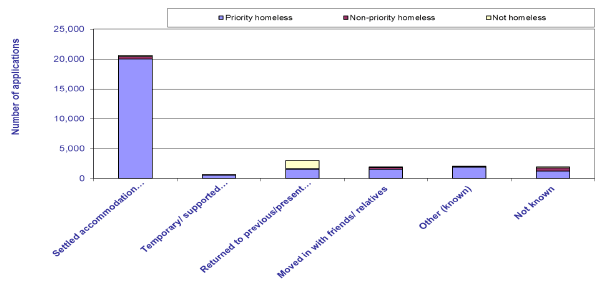
5.5. The number of homeless households securing a social let from either a local authority or housing association increased from 11,666 in 2002-03 to a peak of 21,248 lets in 2009-10. The total number of social lets to homeless households has fallen back slightly and now stands at 18,243 in 2012-13. Comparing 2012-13 and 2002-03, there has been an increase of 6,577 (+56%) social lets to homeless households. (Chart 22 and Table 8a)
5.6. There has been a marked increase in the number of homeless households securing a housing association tenancy - increasing from 1,487 in 2002-03 to a peak of 8,263 in 2009-10 since when it has reduced to 6,752 in 2012-13. The increase in housing association lets to homeless households is partly explained by stock transfers in six local authority areas[11] to housing associations created for this purpose. For these local authorities, what would have been classified as local authority lets are now classed as housing association lets.
Chart 22: Scotland: Accommodation secured by homeless applicants
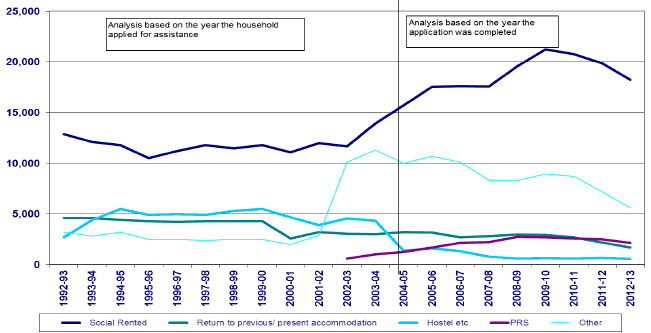
Action taken to prevent homelessness
5.7. A question introduced from 1 April 2007 asks councils, at the time they close an application, to identify action they took to prevent homelessness for households assessed as threatened with homelessness or assessed as not homeless. Councils can record more than one prevention activity for each application. Chart 23 shows prevention actions taken for the 4,429 households who were assessed as threatened with homelessness or not homeless and whose case was closed in 2012-13. Of these, 1,452 (33%) were provided with an assessment of their support needs, 1,172 (26%) were provided with assistance in finding alternative accommodation, 809 (18%) received independent financial, legal or housing advice, 641 (14%) received basic housing support, 339 (8%) received assistance in dealing with their landlord or mortgage provider, 258 (6%) had assistance in claiming benefits, 167 (4%) were assisted to use a rent deposit/ guarantee scheme, for 186 (4%) a Social Work/ Health/ or Community Care service was involved and services such as counselling or mediation were provided for 266 (6%).
5.8. The distribution of prevention activities recorded for applicants remains broadly unchanged from 2011-12.
Chart 23: Scotland: 2012-13: Actions taken to prevent homelessness
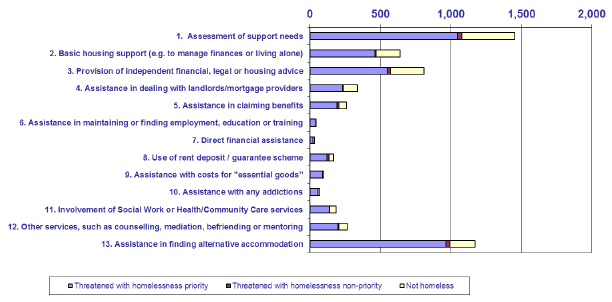
Homeless share of social lets
5.9. The majority of homeless households who secure a social let following their homeless application do so because they are assessed as unintentionally homeless and in priority need. In such cases an offer of a social let is made and the household accepts this. In addition to this, some other homeless households secure a social let during the period of their application - perhaps because they were already on a local authority or housing association waiting list. During the period of their homelessness application, they are offered and accepted a let. The homelessness statistics (HL1) system records both types of outcome. In other statistical sources (such as local authority and housing associations' letting statistics) the lets secured through the discharge of local authorities' statutory duties are often described as lets to statutory homeless or, in the case of housing associations, they are called section 5 referrals or homeless nominations.
5.10. Chart 24 shows the number of social lets secured by homeless households in each year since 2002-03, by homeless assessment decision. Over the period, numbers securing a social let by both means have initially increased and then fallen back slightly. This reflects the increasing numbers of homeless households who have been given priority status, and the more recent reductions in homeless applications.
Chart 24: Social lets secured by homeless households by assessment decision
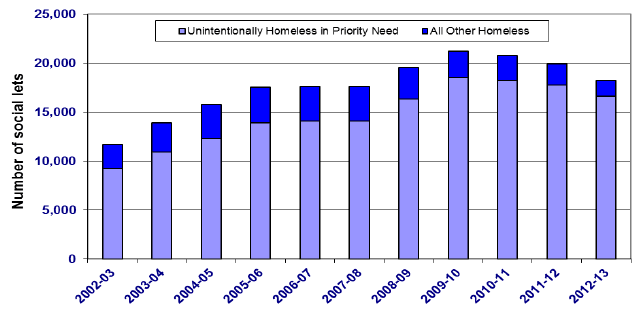
Chart 25: Estimated homeless share of local authority and housing association lets (excluding transfers) 2003-04 to 2012-13
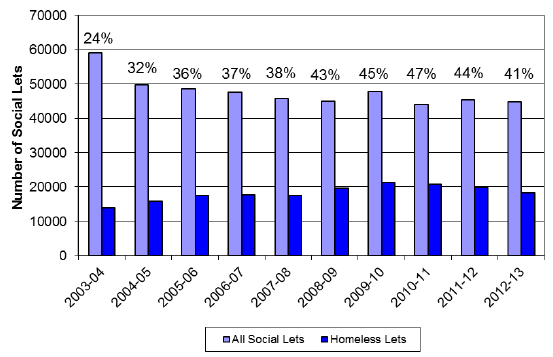
5.11. Overall homeless lets (statutory and other means) accounted for an estimated 41% of available social lets during 2012-13. (Chart 25).
5.12. Chart 26 shows for each local authority area the estimated[12] proportion of social lets (excluding transfer lets) secured by homeless households by assessment decision. The estimated proportion of social lets secured by homeless households in 2012-13 varied from 70% in East Lothian to 20% East Ayrshire.
5.13. In East Dunbartonshire, 234 social lets were secured by cases assessed as homeless or threatened with homelessness. Of these, 113 were secured by cases assessed as unintentionally homeless and in priority need. Of the remaining 121 social lets secured, the vast majority of these (116 out of 121) had been assessed as threatened with homelessness, unintentionally so and are in priority need. These households are likely to become homeless within two months. The Council is securing alternative accommodation before these households lose their existing accommodation. This approach has resulted in homeless and potentially homeless households securing a relatively high proportion of available social lets - an estimated 62% of all non-transfer social lets in 2012-13. By giving a high proportion of lets to homeless households, East Dunbartonshire has continued the trend seen in 2011/12 and seen a small decrease in the number of homeless households in temporary accommodation.
Chart 26: Estimated homeless share of local authority and housing association lets (excluding transfers) in 2012-13
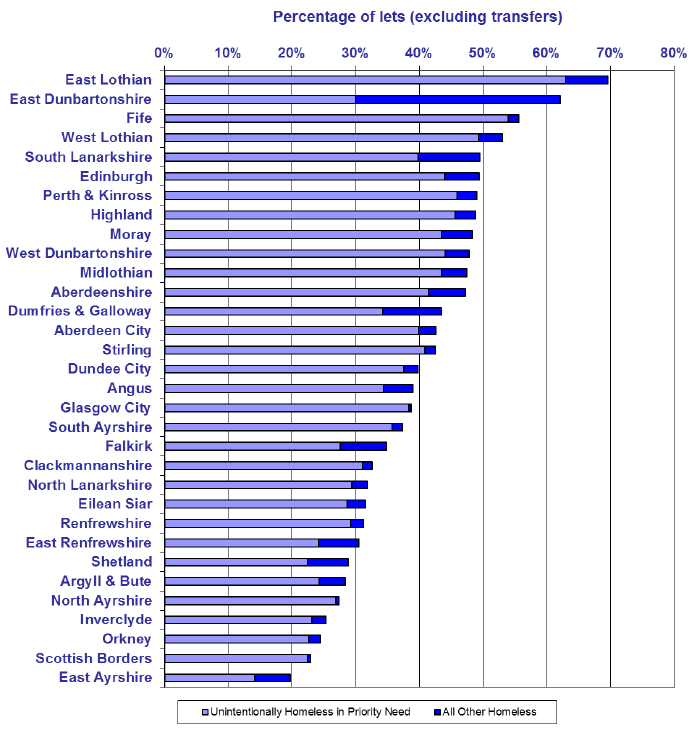
Contact
There is a problem
Thanks for your feedback